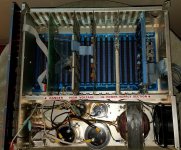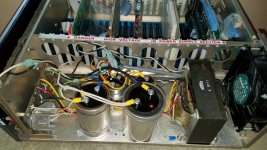zippysticks
Veteran Member
Folks,
I have taken an expensive plunge and bought this IMSAI 8080 machine from via Ebay.
It looks like it has been apart a lot and hasn't really been put back together properly.
Discounting its obviously wrong steel cover - I'm looking at a replacement from the folks at imsai.net - I can see a few challenges with this unit:
It has had a TinkerToys Wunderbuss Noiseguard S100 backplane installed. This would appear to be an 18/20 slot backplane. I can find details of these boards up to 12 slots but does anyone have any details for this larger model ?
The other thing that looks odd is the power supply - I don't recognise much beyond the transformer type it is using - a Tranex 4-3751.
This does appear in the BOM for the IMSAI PS-28D unit so I"m assuming is original. I would have preferred the Tranex 4-3819-1 used in the PS-28U for use in the UK as it is capable of being configured for 240V input.
Does anyone recognise this PSU layout - is appears different from everything else I have seen and doesn't seem to make use of a PCB mounting to house the components. Instead the major components (transformer and caps) seem to be mounted to the chassis and then fed to the rectifiers etc. on a small board mounted behind the front of the chassis.
As this machine is not working, the plan is to disconnect everything that has been done before and rebuild working through the power supply to start with.
I have variac that I can use to to test the power supply once it has been rebuilt - any other advice appreciated.


I have taken an expensive plunge and bought this IMSAI 8080 machine from via Ebay.
It looks like it has been apart a lot and hasn't really been put back together properly.
Discounting its obviously wrong steel cover - I'm looking at a replacement from the folks at imsai.net - I can see a few challenges with this unit:
It has had a TinkerToys Wunderbuss Noiseguard S100 backplane installed. This would appear to be an 18/20 slot backplane. I can find details of these boards up to 12 slots but does anyone have any details for this larger model ?
The other thing that looks odd is the power supply - I don't recognise much beyond the transformer type it is using - a Tranex 4-3751.
This does appear in the BOM for the IMSAI PS-28D unit so I"m assuming is original. I would have preferred the Tranex 4-3819-1 used in the PS-28U for use in the UK as it is capable of being configured for 240V input.
Does anyone recognise this PSU layout - is appears different from everything else I have seen and doesn't seem to make use of a PCB mounting to house the components. Instead the major components (transformer and caps) seem to be mounted to the chassis and then fed to the rectifiers etc. on a small board mounted behind the front of the chassis.
As this machine is not working, the plan is to disconnect everything that has been done before and rebuild working through the power supply to start with.
I have variac that I can use to to test the power supply once it has been rebuilt - any other advice appreciated.


Last edited:

